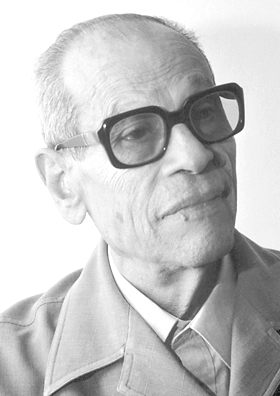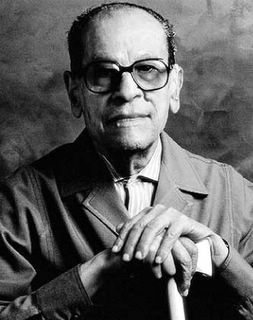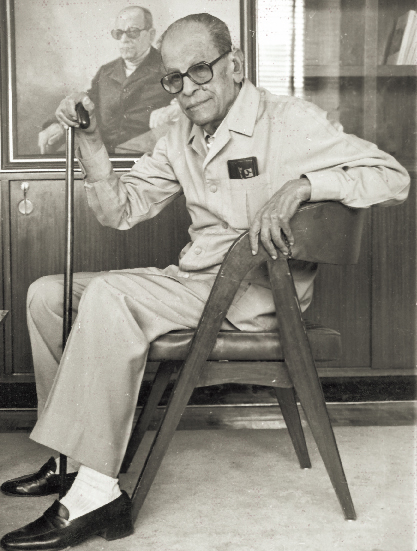<Back to Index>
- Mathematician Josip Plemelj, 1873
- Writer Naguib Mahfouz, 1911
- Founder of the Christian Social Party Adolf Stoecker, 1835
PAGE SPONSOR



Naguib Mahfouz (Arabic: نجيب محفوظ, Nagīb Maḥfūẓ) (December 11, 1911 – August 30, 2006) was an Egyptian writer who won the 1988 Nobel Prize for Literature. He is regarded as one of the first contemporary writers of Arabic literature, along with Tawfiq el-Hakim, to explore themes of existentialism. He published over 50 novels, over 350 short stories, dozens of movie scripts, and five plays over a 70 year career. Many of his works have been made into Egyptian and foreign films.
Born into a lower middle class Muslim family in the Gamaleyya quarter of Cairo, Mahfouz was named after Professor Naguib Pasha Mahfouz (1882 – 1974), the renowned Coptic physician who delivered him. Mahfouz was the seventh and the youngest child in a family that had five boys and two girls. The family lived in two popular districts of the town, in el-Gamaleyya, from where they moved in 1924 to el-Abbaseyya, then a new Cairo suburb; both provided the backdrop for many of Mahfouz's writings. His father, whom Mahfouz described as having been "old-fashioned", was a civil servant, and Mahfouz eventually followed in his footsteps. In his childhood Mahfouz read extensively. His mother often took him to museums and Egyptian history later became a major theme in many of his books.
The Mahfouz family were devout Muslims and Mahfouz had a strictly Islamic upbringing. In an interview, he painfully elaborated on the stern religious climate at home during his childhood years. He stated that "You would never have thought that an artist would emerge from that family."
The Egyptian Revolution of 1919 had
a strong effect on Mahfouz, although he was at the time only seven
years old. From the window he often saw British soldiers firing at the
demonstrators, men and women. "You could say," he later noted, "that
the one thing which most shook the security of my childhood was the
1919 revolution." After completing his secondary education, Mahfouz entered King Fouad I University (now the University of Cairo),
where he studied philosophy, graduating in 1934. By 1936, having spent
a year working on an M.A., he decided to become a professional writer.
Mahfouz then worked as a journalist at er-Risala, and contributed to
el-Hilal and Al-Ahram. The major Egyptian influence on Mahfouz's thoughts of science and socialism in the 1930s was Salama Moussa, the Fabian intellectual. Mahfouz
left academia and pursued a career in the Ministry of Religious
affairs. However, he was soon moved to a role in the Ministry of
Culture as the official responsible for the film industry, due to his
apparent atheism. A
longtime civil servant, Mahfouz served in the Ministry of Mortmain
Endowments, then as Director of Censorship in the Bureau of Art,
Director of the Foundation for the Support of the Cinema, and finally
as a consultant to the Ministry of Culture. Mahfouz
left his post as the Director of Censorship and was appointed Director
of the Foundation for the Support of the Cinema. He was a contributing
editor for the leading newspaper Al-Ahram and in 1969 he became a consultant to the Ministry of Culture, retiring in 1972. Mahfouz
remained a bachelor until the age of 43. The reason for his late
marriage was that he laboured under his conviction that with its
numerous restrictions and limitations, marriage would hamper his
literary future. In 1954, he married an Egyptian woman, with whom he
had two daughters. He
published 34 novels, over 350 short stories, dozens of movie scripts
and five plays over a 70 year career. Many of his works have been made
into Egyptian films. He was a board member of the publisher Dar el-Ma'aref. Many of his novels were serialized in Al-Ahram,
and his writings also appeared in his weekly column, "Point of View".
Before the Nobel Prize only a few of his novels had appeared in the
West. Mahfouz did not shrink from controversy outside of his work. As a consequence of his outspoken support for Sadat's Camp David peace treaty with Israel in 1978, his books were banned in many Arab countries until after he won the Nobel Prize. Like many Egyptian writers and intellectuals, Mahfouz was on an Islamic fundamentalist "death list". He defended Salman Rushdie after Ayatollah Ruhollah Khomeini condemned Rushdie to death in 1989, but also criticized his Satanic Verses as
"insulting" to Islam. Mahfouz believed in freedom of expression and
although he did not personally agree with Rushdie's work, he did not
believe that there should be a fatwa condemning him to death for it. He also condemned Khomeini for issuing the fatwa, for he did not believe that the Ayatollah was representing Islam. In 1989, after Ayatollah Ruhollah Khomeini's fatwa calling for Salman Rushdie and his publishers to be killed, Mahfouz called Khomeini a terrorist. Shortly after Mahfouz joined 80 other intellectuals in declaring that "no blasphemy harms Islam and Muslims so much as the call for murdering a writer."
The appearance of
The Satanic Verses
brought back up the controversy surrounding Mahfouz's novel
Children of Gebelawi. Death threats against Mahfouz followed, including one from the "blind sheikh," Egyptian theologian
Omar Abdul - Rahman.
Like Rushdie, Mahfouz was given police protection, but in 1994 Islamic
extremists almost succeeded in assassinating the 82 year old novelist
by stabbing him in the neck outside his Cairo home. He
survived, permanently affected by damage to nerves in his right hand.
After the incident Mahfouz was unable to write for more than a few
minutes a day and consequently produced fewer and fewer works.
Subsequently, he lived under constant bodyguard protection. Finally, in
the beginning of 2006, the novel was published in Egypt with a preface
written by Ahmad Kamal Aboul - Magd. After
the threats, Mahfouz stayed in Cairo with his lawyer Nabil Mounier
Habib. Mahfouz and Habib would spend most of their time in Habib's
office; Mahfouz used Habib's library as a reference for most of his
books. Mahfouz stayed with Habib until his death. Prior to his death,
Mahfouz was the oldest living Nobel Literature laureate and the third
oldest of all time, trailing only Bertrand Russell and Halldor Laxness. At the time of his death, he was the only Arabic - language writer to have won the Nobel Prize. In
July 2006, Mahfouz sustained an injury to his head as a result of a
fall. He remained ill until his death on August 30, 2006 in a Cairo hospital. In
his old age Mahfouz became nearly blind, and though he continued to
write, he had difficulties in holding a pen or a pencil. He also had to
abandon his daily habit of meeting his friends at coffee houses. Prior
to his death, he suffered from a bleeding ulcer, kidney problems, and cardiac failure. Mahfouz
was accorded a state funeral with full military honors on August 31,
2006. His funeral took place in the Al-Rashdan Mosque in Nasr City in Cairo. Mahfouz
dreamed that all of the social classes of Egypt, including the very
poor, would join his funeral procession. However, attendance was
tightly restricted by the Egyptian government amid protests by mourners. Most of Mahfouz's early works were set in el-Gamaleyya. Abath Al-Aqdar (Mockery of the Fates) (1939), Rhadopis (1943), and Kifah Tibah (The Struggle of Thebes) (1944), were historical novels, written as part of a larger unfulfilled project of 30 novels. Inspired by Sir Walter Scott (1771 – 1832) Mahfouz planned to cover the whole history of Egypt in
a series of books. However, following the third volume, Mahfouz shifted
his interest to the present, the psychological impact of the social
change on ordinary people. Mahfouz's central work in the 1950s was the Cairo Trilogy, an immense monumental work of 1,500 pages, which the author completed before the July Revolution. The novels were titled with the street names Palace Walk, Palace of Desire, and Sugar Street. Mahfouz set the story in the parts of Cairo where he grew up. They
depict the life of the patriarch el-Sayyed Ahmed Abdel Gawad and his
family over three generations, from World War I to the 1950s, when King Farouk I was
overthrown. With its rich variety of characters and psychological
understanding, the work connected Mahfouz to such authors as Balzac, Dickens, Tolstoy, and Galsworthy. Mahfouz ceased to write for some years after finishing the trilogy. Disappointed in the Nasser régime,
which had overthrown the monarchy in 1952, he started publishing again
in 1959, now prolifically pouring out novels, short stories, journalism, memoirs, essays, and screenplays. Tharthara Fawq Al-Nīl ("Chatter on the Nile"; 1966) is one of his most popular novels. It was later made into a film featuring a cast of top actors during the time of president Anwar al-Sadat.
The film/story criticizes the decadence of Egyptian society during the
Nasser era. It was banned by Sadat to avoid provocation of Egyptians
who still loved former president Nasser. Copies were hard to find prior
to the late 1990s. Mahfouz's prose is characterised by the blunt
expression of his ideas. His written works covered a broad range of
topics, including socialism, homosexuality, and God. Writing about some of the subjects was prohibited in Egypt. The Children of Gebelawi (1959,
also known as "Children of our Alley") one of Mahfouz's best known
works, has been banned in Egypt for alleged blasphemy over its
allegorical portrayal of God and the monotheistic Abrahamic faiths of Judaism, Christianity,
and Islam, until the ban was released in 2006. It portrayed the
patriarch Gebelaawi and his children, average Egyptians living the
lives of Cain and Abel, Moses, Jesus, and Mohammed.
Gebelawi has built a mansion in an oasis in the middle of a barren
desert; his estate becomes the scene of a family feud which continues
for generations. "Whenever someone is depressed, suffering or
humiliated, he points to the mansion at the top of the alley at the end
opening out to the desert, and says sadly, 'That is our ancestor's
house, we are all his children, and we have a right to his property.
Why are we starving? What have we done?'" The book was banned
throughout the Arab world, except in Lebanon,
and in Egypt where the novel was published in 2006. In the 1960s,
Mahfouz further developed its theme that humanity is moving further
away from God in his existentialist novels. In The Thief and the Dogs (1961) he depicted the fate of a Marxist thief, who has been released from prison and plans revenge. In the 1960s and 1970s Mahfouz began to construct his novels more freely and to use interior monologues. In Miramar (1967)
he developed a form of multiple first - person narration. Four narrators,
among them a Socialist and a Nasserite opportunist, represent different
political views. In the center of the story is an attractive servant
girl. In Arabian Nights and Days (1981) and in The Journey of Ibn Fatouma (1983) Mahfouz drew on traditional Arabic narratives as subtexts. Akhenaten, Dweller in Truth (1985) is about conflict between old and new religious truths. Many of his novels were first published in serialized form, including Children of Gebelawi and Midaq Alley which was adapted into a Mexican film starring Salma Hayek (El callejón de los milagros). Mahfouz
described the development of his country in the 20th century. He
combined intellectual and cultural influences from East and West - his
own exposure to the literarature of non-Egyptian culture began in his
youth with the enthusiastic consumption of Western detective stories,
Russian classics, and such modernist writers as Marcel Proust, Franz Kafka and James Joyce. Mahfouz's stories, written in the florid classical Arabic,
are almost always set in the heavily populated urban quarters of Cairo,
where his characters, mostly ordinary people, try to cope with the
modernization of society and the temptations of Western values. Most
of Mahfouz's writings mainly dealt with politics, a fact which he
himself once emphasized: "In all my writings, you will find politics.
You may find a story which ignores love or any other subject, but not
politics; it is the very axis of our thinking". He greatly espoused Egyptian nationalism in many of his works, and expressed sympathies for the post World War era Wafd Party.
He was also attracted to socialist and democratic ideals early on in
his youth. The influence of Socialist ideals is strongly reflected in
his first two novels, Al-Khalili and New Cairo, and also in many of his
latter works. However, in spite of his firm belief in socialism,
Mahfouz was never a Marxist in any sense of the word. Parallel to his sympathy for socialism and democracy was his antipathy towards Islamic extremism as expressed by the Muslim Brotherhood in
Egypt. He strongly criticized radical Islam in his works and contrasted
between the merits of Socialism and the demerits of Islamic extremism
in his first two novels. He perceived Islamism as critically delineated
and rejected it as unsuitable for all times. In his memoirs, he stated
that out of all the forces active in Egyptian politics during his
youth, he always despised the Muslim Brotherhood. Mahfouz had personally known Sayyid Qutb in
his youth, then showing a greater interest in literary criticism than
in Islamic fundamentalism; Qutb later became a significant influence on
the Muslim Brotherhood. In fact, Qutb was one of the first critics to
recognize Mahfouz's talent in the mid 1940s. Mahfouz even visited Qutb
when the latter was in the hospital, during the 60s, near the end of
his life. In his semi-autobiographical novel, Mirrors, he drew a very negative portrait of Sayyid Qutb. He was greatly disillusioned with the 1952 revolution and by Egypt's defeat in the 1967 Six-Day War.
He opposed the 1952 revolution not because of its principles, but
because he felt that the practices failed to live up to them.